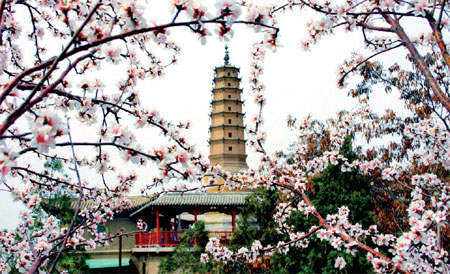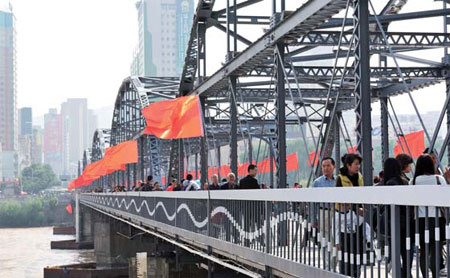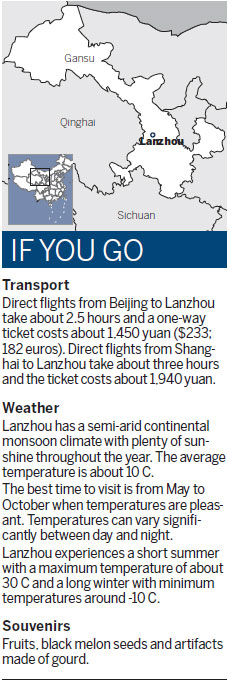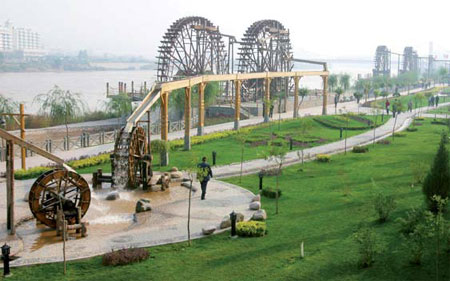Rolling on a river
Updated: 2012-11-16 11:24
(China Daily)
|
|||||||||||

|
Top: The 17-meter centuries-old pagoda in Baita Mountain Park. Above: Lanzhou Waterwheel Park along the Yellow River. Below: Zhongshan Bridge. Photos Provided to China Daily |

Lanzhou begins to shine, and foreign tourists have noticed it
It used to be called the Golden City many centuries ago, but these days Lanzhou is basking in economic success that makes it once again worthy of that name. That success is reflected in the increasing prosperity of the province of which Lanzhou is the capital, Gansu, which until about 60 years ago was poverty-stricken.
Lanzhou itself has become an important production base for petrochemicals and raw materials, and with rapid development over the past decade has become a center for trade in the west of China.
The city sprawls across more than 1,500 square kilometers, through which runs the great Yellow River from west to east.
Adding a touch of majesty to the city, which is 1,600 meters above sea level, are mountains to the north and south.
Apart from being an important logistics and trading center, the city has also attracted an increasing number of tourists in recent years.
Even though the great majority are Chinese - there were 14 million of them last year - growing numbers of foreign tourists are making their way to Lanzhou, too.
Last year 38,000 visited the city, an increase of 23 percent on the previous year.
Should you decide to follow in their path, here are some things you could see and do there.

1. The Yellow River
Often called the Mother River in China, the Yellow River at 5,464 kilometers, is the country's second-longest after the Yangtze River.
On its south bank as it passes through Lanzhou is a walkway that runs for about 10 kilometers, lined with flowers and green areas.
A half-hour walk along the river here provides an overview of the city, and the riverbank itself holds many tourist attractions, including the Statue of Chinese Mother River, Zhongshan Bridge and Waterwheel Park.
2. Baita Mountain Park
Baita Mountain Park provides great views across the city.
Located on the north bank of the Yellow River, the park is well known for the Baita Temple, built during the Yuan Dynasty (1271-1368) and renovated in 1958.
The park covers 8,000 square meters, and there are numerous viewing decks on the road to the temple. Each deck provides a unique view of old or modern parts of the city.
3. Zhongshan Bridge
Zhongshan Bridge, at the foot of Baita Mountain Park, was built between 1907 and 1909 under the supervision of German and US engineers using materials shipped in from Germany.
It originally served as the only passage from the north bank to the south bank.
Now there are about a dozen bridges crossing the Yellow River in Lanzhou, all superior to the original one in quality and design.
But Zhongshan Bridge remains special for its history and wonderful views of the sunset.
4. Waterwheel Park
Next to Zhongshan Bridge is Waterwheel Park. This museum of waterwheels has an elaborate south gate decorated with the Lanzhou city symbol, which depicts Lanshan Mountain, Baita Mountain and the Yellow River.
Inside the entrance is a statue of Duan Xu, the creator of the distinctive Lanzhou style of waterwheel during the Ming Dynasty (1368-1644). He learned from irrigation machines in Yunnan province and invented a wheel that looks like chariot wheels with a diameter of between 10 and 20 meters.
Besides the typical Lanzhou waterwheel, visitors can see a variety of traditional waterwheels from the south of China.
An hour or two in the park provides a fascinating look into China's agricultural history.
Eating
Lanzhou beef noodles are a speciality and can be bought almost everywhere. There are about 1,100 beef noodle restaurants.
They are so prolific, in Lanzhou they have become known as the "local McDonald's".
Beef noodles are commonly eaten for breakfast. The noodle soup is made with beef, bones and seasoning stewed for several hours.
Normally beef noodle soup in well-known local restaurants such as Mazilu is available until only 2 pm. By that time, it is usually sold out.
China Daily
(China Daily 11/16/2012 page23)
Today's Top News
Rescuers race against time for quake victims
Telecom workers restore links
Coal mine blast kills 18 in Jilin
Intl scholarship puts China on the map
More bird flu patients discharged
Gold loses sheen, but still a safe bet
US 'turns blind eye to human rights'
Telecom workers restore links
Hot Topics
Lunar probe , China growth forecasts, Emission rules get tougher, China seen through 'colored lens', International board,
Editor's Picks

|

|

|

|

|

|






